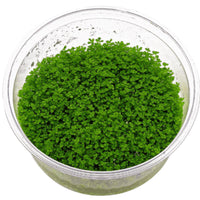Dwarf Baby Tears Plant (Smallest Aquarium Plant)
Overview:
The dwarf baby tears plant is a uniquely challenging aquarium plant that has gained popularity among aquarists. For those of you who are unfamiliar with this species, it's important to note how tiny and versatile it can be in the aquatic environment: perfect for nano tanks or as an accent piece on larger aquariums!
Dwarf Baby Tears Plant (Hemianthus Callitrichoides Cuba) is rather challenging to keep, but a very good looking aquarium plant. This ground-covering is one of the smallest plants available and one of most wanted by aquarists. The low profile makes them perfect for front planks on nano tanks; they're also great as accents in other more sizable setups!
Origin:
In the summer of 1996 at Tropica's headquarters in Las Pozas, Holger Windelov noticed a small plant that had been growing near his office for some time. After investigating further he discovered it was one of two new species called Hemianthus callitrichoides. Being surrounded by large stones and a water level of about 50 cm high made this discovery quite an adventure!
In response to the wet and humid conditions, Hemianthus Callitrichoides Cuba forms thick green glades which provide a sense of security in this otherwise dangerous habitat. The water flow is strong during rain seasons but these plants are resistant to it up until they reach 1 meter deep into their environment.
Since 2003, this plant has been a favourite among hobbyists who want to create naturalistic aquascapes that appeal to their inner fish.
Specification:
The Hemianthus callitrichoides are miniature copies of that of the more common hemiantus micranthemioe. They form small glades about 3-6 cm high, differing from their counterpart in smaller leaves and shorter stems.
Difficulties in keeping
The Hemianthus callitrichoides «Cuba» plant is challenging to keep, but if you are willing to put in the time and effort it will be worth your while. The high demand for minerals makes them a bad choice for beginner aquarists because they have a hard time keeping up with such an extensive list of needs.
These plants require small-grained substrate as well as strong lighting from artificial CO2 supply that must also include fertilization during its growth cycle.
In order to ensure that your dwarf baby tears plants are not crowded out by the neighbouring fast-growing plant, it is important for you to trim and thin them regularly.
Care
The plant, which is tolerant to the condition of little or no light and can still grow successfully in these conditions, will instead elongate at such a lack. If there's never any sun whatsoever then it won't even develop anymore until you have bright lighting again--even if that means having some extra lamps on for now! The stronger your lights are, the thicker their carpet becomes; with stems tightly wrapped around each other when they're under strong illumination.
This plant has its own requirements as far as fertilization goes: especially ferrum content in water needs to be considered because without enough fertilizer leaves become pale and small due to high demand by this particular species. That’s why iron-containing liquid fertilizers should always be used precisely
Dwarf baby tears plants are remarkable for their ability to quickly restore colour after being submerged in water. This makes it an excellent indicator of the iron content within a tank's surface, as well!
With optimal conditions such as CO2 supply and an ideal temperature between 20-28°C, this plant can be grown without much difficulty--though if you don't have these luxuries then just adding them into your aquarium is enough to enjoy them at its full potential
FAQ
Can Hemianthus Callitrichoides Cuba live without CO2?
CO2 is paramount to HCC success - even though this plant-primarily thrives on elevated carbon dioxide levels, these few sensitive ones also serve as excellent living indicators by changing their growth pattern depending on what kind of care they need: more sparsely spaced leaves growing higher up from the ground







